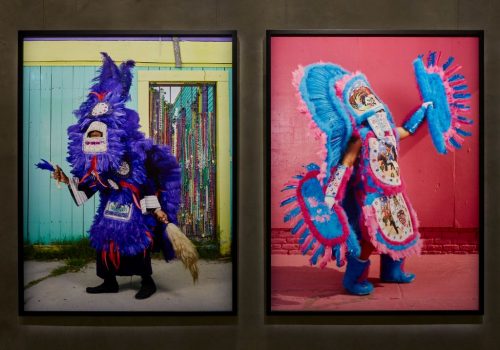Fabula by Charles Fréger, on stage at the Armani/Silos in Milan, goes together with an original storyline and a little bit magic and amazement, all of them essential elements of fairy tales. Indeed, it’s a pretty special fairy tale, that, while fascinating us, tells about different communities, the individuals composing them and the dress codes they adopt in order to be part of a group. It’s an extensive anthological exhibition documenting Freger’s still ongoing research, showing over two hundred and fifty images, from the early Water Polo swimmers series (2000) to more recent images, such as the Mardi Gras Indians series (2016).
Fréger has been focusing for more than 15 years on this issue, conducting his research throughout the world, documenting how humans deal with deepest fears, with the need, or the will to belong, giving back a captivating insight into the visual richness of mankind. With a straight portraiture style, Charles Fréger explores the dress codes of various groups, focusing on the outer strata they adopt, like for instance clothing or ritual masks. His work builds a growing codification of signs, highlighting the power of dresses as a primal means of non-verbal communication. According to his photographic research, groups of images in dialogue with one other are on show creating some kind of visual protocol (linking portraits and uniforms) and emphasizing both the theatricality and the ethnological accuracy of his work. “The exhibition staging at the Armani/Silos contributes to visualize my works chapter by chapter, giving the rhythm to the photographic exhibition. There’s a sensation of time and evolution”, Charles Fréger says.
Fabula as a kind of encyclopedic – though poetic – compendium, try to identify links, rituals and practices that unite individuals in a community, in a group. Yet the outfit, the pose and the clothing are the first reference, together with masks and make-up, that, in the show, are highlighted by the series of Wilder Mann and Yokainoshima, both dedicated to masked traditions in relation to rural life. Colors too are quite interesting in this very context. According to Giorgio Armani, “The vitality of color is what caught my eye first. That color, however, is no mere visual feat: it is a depiction of human energy. As a fashion designer, I know clothing is charged with a great symbolic meaning: Fréger constantly reminds us of that, scavenging the deepest aspects of dressing up as a way of communicating”
The exhibition also includes portraits of the Finnish ice-skating team (Steps) and images of young Sumo wrestlers (Rikishi), a document of European armies and their uniforms (Empire), images of Sikh soldiers (Sikh Regiment of India) and Jaipur elephants (Painted Elephants). Each community has its own code, but the urge to express belonging through clothing is somehow common. “For instance, the uniform is a community visual expression, it represents the connection to a place and a group of people”, Fréger explains. Though, the result is not only the faithful recording of the subjects, but a portrait where the models are subjects with their identity and their dignity. “The artist brings a new way of looking at comparable and differentiating traits, at what bonds together and what breaks apart. But this realism does not cling to expressive details or contours of physiognomy. Charles Fréger’s approach succeeds in capturing the lives of these people”, as Philippe Arbaïzar used to say.
Paola Sammartano
Paola Sammartano is a journalist specialized in arts and photography based in Milan, Italy
Charles Fréger : Fabula
From 12 January to 24 March 2019
Armani/Silos
Via Bergognone 40, Milan
















